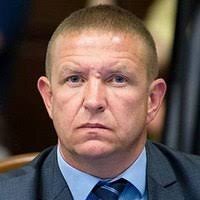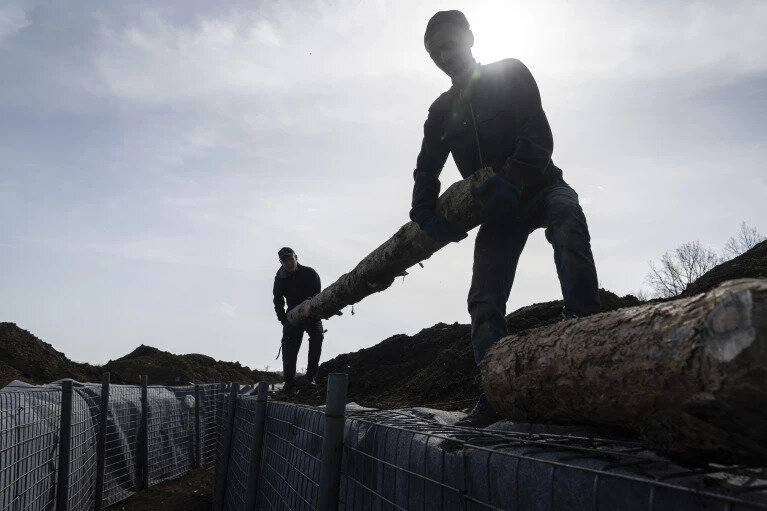Fortifications in Sumy region: Why no construction contracts have been fulfilled yet
Last year, over UAH 3 billion were planned to be spent on rebuilding the fortification system in the Sumy region. However, none of the contracts for constructing defensive structures, carried out by the Department of the Sumy Regional Military Administration (RMA) and the Sumy Recovery and Infrastructure Development Service, were completed. Business Censor investigated the possible reasons behind this.
This year, Russian forces managed to quickly advance deep into the Sumy region, destroying a significant amount of housing and devastating many lives. According to Oleh Hryhorov, the recently appointed head of the Sumy RMA, evacuation has currently been announced in 213 settlements across the region.
On 29 June, the U.S. outlet The Wall Street Journal devoted its lead story to the situation in the Sumy region. The report states that Russia has concentrated 50,000 troops around Sumy, outnumbering the Ukrainian Armed Forces by a ratio of 3 to 1. And that holding the Sumy region currently costs Ukrainians more human lives than was possible, largely due to the lack of fortifications.
"For six months, while Ukraine held territory in Russia’s Kursk region, the soldiers fighting there expected the military to prepare strong defensive positions on the Ukrainian side of the border. Instead, after a chaotic and costly withdrawal from Kursk, they found outdated trenches without protection against drones," writes the American publication.
Meanwhile, last week, Defense Minister Rustem Umerov stated that defensive lines are currently being "improved in areas under threat." He also assured that in 2024, in sectors where construction was carried out by military units, between 96% and 99.9% of the assigned tasks have been completed.
However, in the Sumy region, state funds for fortification construction are also jointly allocated by the local Recovery and Infrastructure Development Service and the Capital Construction Department of the Sumy RMA, both of which hire private contractors.
According to Business Censor, the Capital Construction Department of the Sumy RMA held 116 tenders for "New construction of fortifications in the Sumy region" in 2024. The contractors of these procurements were classified by the RSA.
Only one tender for the supply of materials for construction has a disclosed contractor—LLC "Yuhstal." The company supplied the Capital Construction Department with "materials, products, and structures for the installation of military engineering and fortification facilities (low-visibility obstacles of the MPP type)."
The tenders were conducted through the Prozorro electronic system at the beginning or middle of 2024. The total value of the contracts for fortification construction amounted to UAH 2.87 billion. However, as of today, only one contract, the materials supply from LLC "Yuhstal", is listed in Prozorro as completed or fulfilled. The rest of the fortification construction contracts remain active, meaning they are unfinished.
This year, the Sumy RMA has not announced any new tenders for fortification works.
Meanwhile, the Recovery and Infrastructure Development Service of the Sumy region conducted 42 tenders totaling UAH 1.02 billion, announced over a year ago between March and May 2024. The service signed contracts for fortification construction worth UAH 883 million, none of which have been completed as of today.
Why are fortification contracts in the Sumy region not being fulfilled?
Recently, Hromadske journalist Diana Butsko asked Sumy RMA head Oleh Hryhorov about this, noting that when Ukrainian troops entered Sudzha and journalists traveled there through the Sumy region, they observed that no fortifications were being built nearby. She suggested that perhaps the time available for defense preparation was not fully utilized.
"As for the fortifications, their quality and placement, this information will be provided by the military, who determine where and how the fortifications are built. They construct them and also approve them... It is difficult to assess their readiness without being the end user," replied the head of the Sumy RMA.
To learn more about the construction of defensive structures, Business Censor turned to Mykhailo Bodnar, a member of the temporary special commission (TSC) in the Verkhovna Rada investigating fortification issues and a People`s Deputy from the European Solidarity party.
 – Perhaps you already have the results of the TSC's work to share? What have you managed to find out?
– Perhaps you already have the results of the TSC's work to share? What have you managed to find out?
– Almost all materials received by the TSC are classified as either "secret" or "for official use only." We have also sent a request to the Accounting Chamber. Although we understand that a report that the Accounting Chamber has not approved cannot be taken into account. We still need to know what materials the report was based on. Society demands answers, yet everything is being "kept secret" under the pretext of martial law.
It turns out that in two sectors—the Kharkiv and Sumy directions—more than 20 PSs (platoon strongpoints - ed.note) were not built using the funds allocated to the military administrations. We invited journalists from Bihus.Info, who previously published investigations on fortifications, to the TSC. At my initiative, they were invited to the TSC—other colleagues were not very keen on journalists being present. There was resistance. To hold the conversation, we had to meet outside the government quarter. Only a few TSC members showed up. Most did not attend the meeting with the journalist investigating embezzlement by military administrations during fortification construction, reporting on fly-by-night companies, poor-quality work that fails to meet modern standards, and the absence of anti-drone coverage. In some places, "dragon’s teeth" (anti-tank obstacles - ed.note) are missing; in others, they’re just piled up. There’s no "razor wire" (barbed wire - ed.note) either.
Eight hundred fortification facilities built by the military administrations are supposed to be transferred to the State Special Transport Service (SSTS—a specialized military unit within the Defence Ministry - ed.note). The regional administrations have been crying out that they do not want to keep those fortifications on their books for even a minute, despite the fact that they were the fund holders and contracted the construction. They understood the quality of the work. Using the money allocated by the state, the regional administrations hired expert assessments of the fortifications in order to shift all responsibility onto the site managers.
Of those 800 facilities, the SSTS has taken 25 onto its books; paperwork is underway for another 150. What will be done with the other half-thousand facilities, and how they will be transferred, is unclear, because their quality is poor. Many of those fortifications are already located in occupied territory.
– Approximately what percentage of the fortifications are already on occupied territory? How much money are we talking about that was spent on fortifications now in enemy-held areas?
– The total figure cited for fortification construction was UAH 40 billion. Criminal cases have been opened for half that amount, meaning UAH 20 billion was simply stolen. The SSTS builds PSs for UAH 12–13 million each, whereas the military administrations spend UAH 25 million. in other words, twice as much. That’s half of the embezzled money right there. We were supposed to receive information on the percentage of fortifications left in temporarily occupied territories, but it hasn’t been prepared yet. However, I believe it’s definitely around 20%.
– And are you getting information from the military side?
– Of course, we review their letters. We’ve urged them to write to us. So we contact the military units that have taken new positions. The soldiers tell us that nothing has been built, after a rotation with others who were supposed to build there, the new units arrived and found nothing constructed.
– Are you talking about the Sumy region?
– Yes, there were just some trenches dug. To prevent the soil from collapsing, they covered them with metal mesh, which actually becomes dangerous when shells hit it, as the mesh tears and the fragments scatter, injuring the soldiers. The construction was poor and unprofessional, money was simply buried or stolen.
I believe we’ll get more information if we manage to hold a closed session of the Verkhovna Rada on this matter. We need to gather next week, make a statement, and demand. The VR won’t work for three weeks—this week and two more. Then they’ll meet for a week before going on a four-week vacation. And this is happening in a country at war! It’s outrageous! It’s hard to get anyone together; the deputies are already lounging in the Maldives, sunbathing. Everything that’s happening, including the construction of fortifications, doesn’t "matter to them"—they don’t want to live in this country. We’ll try to convene at least for one day to hear this issue.
– As far as I recall, it wasn’t just fly-by-night companies building the fortifications, but also large firms like "Avtomahistral-Pivden." There were reportedly many questions from law enforcement about them, and criminal cases were opened. The company claimed it was under pressure and that competitors were targeting them this way. How does this look from your perspective?
– We approached the prosecutor’s office; its representatives attended our commission meetings and said, in general terms regarding the fortifications, that criminal proceedings had been opened and that, if the facts were proven, the law-enforcement authorities would have to inform us. So far, we have received no notification, they remain silent.
We want to bring the Prosecutor-General’s Office, the SBI, NABU, SAPO, and the Cabinet before Parliament so they can explain the real situation. We have already heard Prime Minister Shmyhal say that 100 percent of the fortifications have been built, that everything is fine and all the funds have been spent; the regional governors came and claimed the money had been fully spent. Yet it turns out that in Kharkiv and Sumy regions alone, some twenty PSs have not been built. A strongpoint is not just a single concrete shelter. It is a series of trenches requiring a substantial amount of materials and labor to build a single PS, yet here, more than 20 remain unconstructed.

